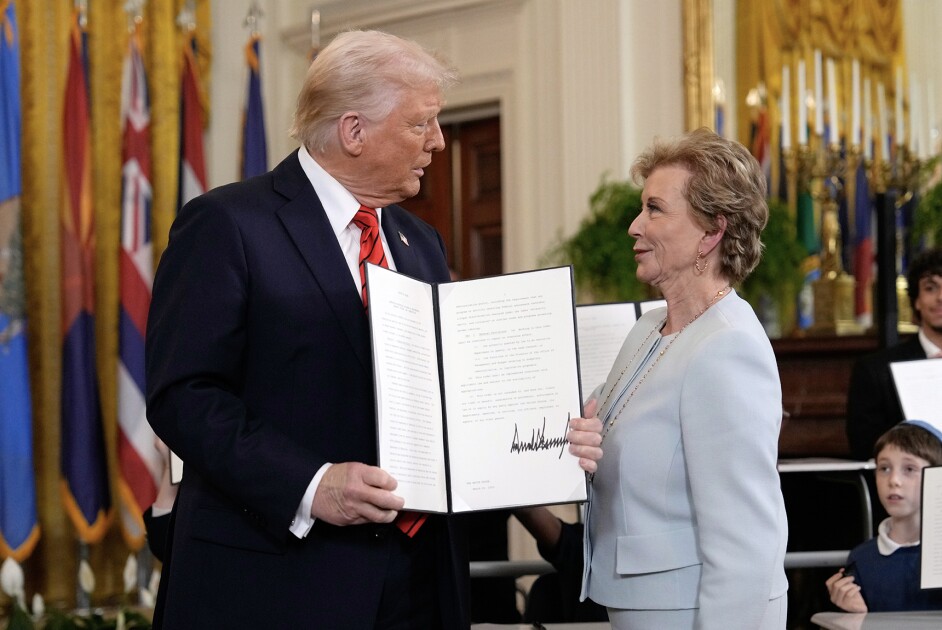President Donald Trump’s administration on Friday revealed the full details of his administration’s sweeping proposal to slash federal education spending, eliminate grant programs worth billions of dollars, and rewrite special education law in unprecedented ways.
The annual White House budget proposal, released with little fanfare just minutes before 5 p.m. on May 30, fleshes out the “skinny budget” documents the administration published earlier in May. These documents are merely proposals and do not have the force of law, and will likely look different from the budget Congress eventually approves for the fiscal year starting this October.
The administration’s core priorities were already clear from the shorter document: $60 million in new annual funding for charter school grants; a sharp overall reduction in federal agency staffing and funding support for K-12 education, and changes that aim to shift federal education responsibilities to states.
Overall, the proposal would reduce the U.S. Department of Education’s budget by 15 percent, to $66.7 billion from $79.6 billion.
As Trump and Education Secretary Linda McMahon have promised repeatedly in recent months, the administration is proposing to cut the overall bottom line for the Education Department while maintaining level funding for two core streams of K-12 funding: Title I-A for low-income students ($18.4 billion) and IDEA Part B grants for students with disabilities ($14.9 billion).
The proposal does, however, recommend changes that would affect both programs. The administration wants to eliminate funding for a smaller Title I grant program that serves migrant students ($52.1 million), and consolidate another Title I program, for education in prisons ($49.2 million), into a block grant states can spend largely as they see fit.
The White House also wants to transform the Individuals with Disabilities Education Act for the first time into a single set of funds that flows to states, effectively eliminating six separate streams that help states invest in legally required programs including preschool for students with disabilities; information centers that help parents navigate special education law and policy; and technology tools that support instruction for students with disabilities.
The proposal document frames the changes as an “increased investment” in core funding for special education. But the proposal actually amounts to flat funding for IDEA as a whole. Roughly $644 million from the six programs proposed for consolidation would shift to IDEA Part B—the primary funding streams for services for students with disabilities—and Congress would need to adopt “new appropriations language” that allows states to use IDEA Part B funds on those priorities, the proposal says. The budget would retain funding for IDEA Part C, which funds special-education services for infants and toddlers with disabilities, as a separate funding stream
Giving states more flexibility to spend funds according to their biggest needs isn’t inherently harmful, said Meghan Burke, a professor of special education at Vanderbilt University.
But states aren’t always best-positioned to deliver mandated services, she said. For instance, parent information centers help families of children with disabilities develop positive relationships with their local schools. States might have a conflict of interest if they’re funding organizations that, in some cases, help parents pursue legal cases against states over their special education obligations.
“When you’re not relying on state funding, and you’re federally funded, then parent centers can be a little more unbiased,” Burke said.
Trump wants to slash a wide range of existing education grants
Roughly half the $12 billion in overall proposed cuts affect programs for K-12 schools, with another $4.3 billion in cuts proposed for higher education, according to early calculations from Sarah Abernathy, executive director of the Committee for Education Funding, a nonprofit coalition of education advocates.
Outside of Title I and IDEA, several longstanding education funding programs are on the chopping block.
The administration wants to eliminate nearly a billion dollars in annual funding to support English learners (Title III), as well as grants for education research; community schools; and preparation programs for teachers and school leaders.
It also wants to condense 18 existing grant programs into a single “simplified education fund” that would let states choose where and how to spend federal dollars. That would mean ending existing funding programs designed to be spent on discrete priorities like services for homeless students; rural schools; after-school programs; and instruction on literacy, civics, and the arts. Seven of the grant programs currently go to states through funding formulas, and the others are competitive grants.
In its budget proposal, the Trump administration says it’s trying to move away from federal school funding that’s “doled out as part of numerous small, poorly designed programs that create silos and are ill-suited to state-specific contexts” and lead to the need for state-level administrators to apply for competitive grants and ensure compliance with federal rules.
All told, the 18 programs totaled $6.5 billion in the most recently enacted federal budget. Trump’s proposed total for the consolidated grant is $2 billion—amounting to an overall funding cut of nearly 70 percent.
“All those programs are funding specific things for school districts,” said Abernathy. “It will be harder for them if this were enacted to continue to use the money the old way if there’s tremendous pressure to do something else.”
The funding programs proposed for consolidation also include grants supporting school safety initiatives; rural schools; and services for Native Hawaiian and Alaska Native students.
The two biggest grant programs proposed for the consolidation are Title II grants that support professional development ($2.2 billion in 2024) and Title IV-A grants for academic enrichment ($1.4 billion in 2024). Title IV-A itself was the result of a consolidation of several programs under the Every Student Succeeds Act in 2015, and schools have wide latitude in spending those funds.
Meanwhile, the Institute for Education Sciences, the department’s research arm, would see two-thirds of its budget disappear, dropping to $261.3 million from $793.1 million. It would retain reduced funding for its assessment activities—chiefly, the National Assessment of Educational Progress—but lose most of its funding that supports education research.
The proposal to slash IES’ budget follows the sudden termination of many research and data collection contracts in February.
Trump is proposing flat funding with no cuts for a handful of programs, including Impact Aid for schools on federally owned land, Indian Education grants to support Native American students, and Perkins grants for career and technical education.
Schools are already seeing the Trump administration’s priorities play out in funding
Schools will start feeling the direct effects of the federal fiscal year 2026 budget as early as July 2026. Most federal programs for K-12 schools are “forward-funded,” which means funding approved during one fiscal year arrives in schools the following fiscal year.
But the Trump administration has already moved aggressively in recent months to advance its agenda by terminating dozens of contracts and pulling back billions of dollars Congress already appropriated.
It also hasn’t published its legally mandated spending plan for the fiscal year 2025 funds approved in March by Congress as part of a “continuing resolution.”
The administration has already canceled billions of dollars in funding for three teacher-preparation grant programs; more than $1 billion in grants for mental health services in schools; and more than $4 billion in remaining pandemic relief funds for expenses like construction, tutoring, and services for homeless students.
(In its budget proposal, the administration requests no funding for any of those three teacher-preparation programs.)
Without the detailed fiscal year 2025 totals for every program, recipients of funding from programs like Title II for professional development are worried the money they’re expecting won’t arrive as scheduled this July.
Abernathy believes districts that receive funding from Title II grants and other programs proposed for eventual elimination should brace for the possibility that the Trump administration will decline to spend the funds Congress already approved for those programs.
That strategy, known as impoundment, has already drawn a slew of court challenges and investigations from the Government Accountability Office. But without a firm resolution, districts should prepare for further disruption, Abernathy said.
On the other hand, she expects Congress may not end up passing a budget that encompasses all of Trump’s stated education priorities. House Republicans have failed several times in years to approve a budget that included steep education funding cuts.
“I know that many Republicans want to deliver on President Trump’s goals, but I’m hoping that they will once again not want to cut funding for their constituents,” Abernathy said.

